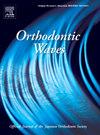Analysis of orthodontic wire springback to simplify wire bending
IF 0.5
Q4 DENTISTRY, ORAL SURGERY & MEDICINE
引用次数: 2
Abstract
ABSTRACT Purpose: This study aims to analyse the springback behaviour of commercial orthodontic wires. Materials and methods: The relationship between the predetermined bending angle (x) and the obtained bent angle (y) of commercial stainless steel (SS) and cobalt-chromium alloy (Co-Cr) orthodontic round wires was analysed. The springback value was calculated from the difference between the two angles (x – y). Results: The springback value became larger when (1) the SS wire was used instead of Co-Cr wire, (2) the wire diameter was small, and (3) the curvature radius was large. The relationship can be adequately represented by a linear function in the form of y = ax + b (R 2 > 0.98). Conclusion: By calculating the inverse of the function, i.e. x = (y – b)/a, the necessary bending angle (x) for the desired bent angle (y) can be calculated in advance, thereby obtaining the desired angle in a single bending action. Analysis of the springback property of the orthodontic wire and utilization of the linear function between x and y for a particular shape and composition of wire can help improve accuracy in wire bending.正畸金属丝回弹分析简化金属丝弯曲
摘要目的:本研究旨在分析商用正畸线的回弹行为。材料与方法:分析了商用不锈钢(SS)和钴铬合金(Co-Cr)正畸圆丝的预定弯曲角度(x)与获得的弯曲角度(y)之间的关系。回弹值是根据两个角度(x–y)之间的差值计算得出的。结果:当(1)使用SS钢丝代替Co-Cr钢丝时,(2)钢丝直径较小,(3)曲率半径较大时,回弹值变大。该关系可以用y=ax+b(R2>0.98)形式的线性函数来充分表示。结论:通过计算函数的倒数,即x=(y–b)/a,可以预先计算出所需弯曲角度(y)的必要弯曲角度(x),从而在单个弯曲动作中获得所需角度。分析正畸金属丝的回弹特性,并针对特定的金属丝形状和成分利用x和y之间的线性函数,可以帮助提高金属丝弯曲的精度。
本文章由计算机程序翻译,如有差异,请以英文原文为准。
求助全文
约1分钟内获得全文
求助全文
来源期刊

Orthodontic Waves
DENTISTRY, ORAL SURGERY & MEDICINE-
CiteScore
0.40
自引率
0.00%
发文量
0
期刊介绍:
Orthodontic Waves is the official publication of the Japanese Orthodontic Society. The aim of this journal is to foster the advancement of orthodontic research and practice. The journal seeks to publish original articles (i) definitive reports of wide interest to the orthodontic community, (ii) Case Reports and (iii) Short Communications. Research papers stand on the scientific basis of orthodontics. Clinical topics covered include all techniques and approaches to treatment planning. All submissions are subject to peer review.
 求助内容:
求助内容: 应助结果提醒方式:
应助结果提醒方式:


